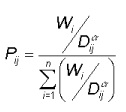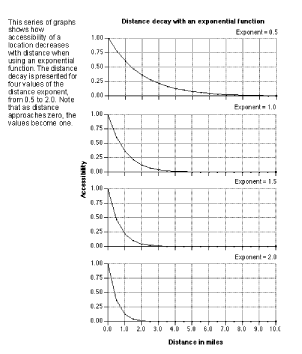Disponible con licencia de Business Analyst.
The Huff Model is an established theory in spatial analysis. It is based on the principle that the probability of a given consumer visiting and purchasing at a given site is a function of the distance to that site, its attractiveness, and the distance and attractiveness of competing sites.
This specific model, in the area of spatial interaction research, was refined and made operational by Dr. David Huff of the University of Texas nearly 40 years ago. The advent of powerful desktop computers has made it possible to apply the model.
The basic Huff formulation of the Gravity Model takes the following form:

Where:
Pij = the probability of consumer j shopping at store i.
Wi = a measure of the attractiveness of each store or site i.
Dij = the distance from consumer j to store or site i.
a = an exponent applied to distance so the probability of distant sites is dampened. It usually ranges between 1.5 and 2.
In practice, census polygons (for example, block groups) are substituted for individual consumers. The calculated probability for each polygon is multiplied by a data element in the polygon database (for example, households and dollars spent on groceries). This measure can be summarized to give an estimate of the total. Some measure of size, such as gross leasable area (GLA), is often used as a surrogate for attractiveness.
A site has many attributes that make it attractive to consumers. Attractiveness can be computed as a function of many attributes. For a retail store, these would be its retail floor space, number of parking spaces, and product pricing. Attractiveness of a car dealership could be a function of its display area, frontage, and advertisement. The attractiveness of an office building could be a function of the number of offices currently located within it. Attractiveness is expressed as one number that combines all the factors that make a center attractive. This one number is usually referred to as an index. This index could also be derived by counting how many people come to that destination or by conducting a consumer survey.
You can control the distance the Huff Model will extend. Enter a value that will encompass all your competitors. You can use the Measure tool to estimate the distance. The distance units can be either miles or kilometers.
Listed below are some commonly used terms and their meanings in the context of gravity models.
Distance-decay function
The perception of how far a destination is may not be a linear function of distance. People are more likely to shop at a place close to home than one far away. Distance is viewed as a nonlinear deterrent to movement. This phenomenon can be modeled by using a distance-decay function. The use of a power distance-decay function is borrowed from Newton's law of gravitation, from which the term gravity model is derived. A distance-decay parameter, symbolized by the Greek letter beta, can be used to exaggerate the distance to destinations. Some activities, such as grocery shopping, have a large exponent, indicating that people will travel only a short distance for such things. Other activities, such as furniture shopping, have a small exponent, because people are willing to travel farther to shop for furniture.

The exponential function is typically used for computing interactions over a small distance, such as within a city.
All Huff Model inputs, exponents, trade area size, and results require detailed analysis by someone who is well versed in the operation of such a model. Some calibration is always required to account for other factors such as leakage (when people don't buy all their groceries at supermarkets, some of that spending leaks to other trade areas such as convenience stores, farmer's markets, and mail order options).